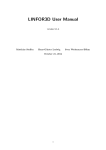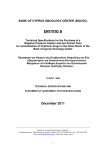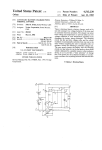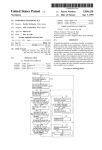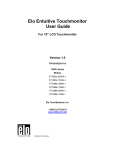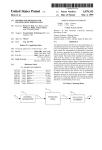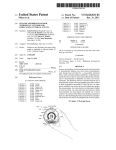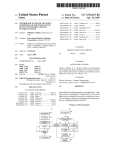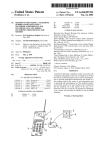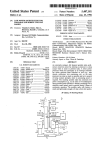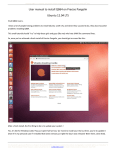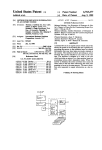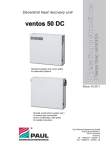Download |llllllllllllllllllllllllllIllllllllllllllllllllllllllllIlllllllllllllllll
Transcript
|llllllllllllllllllllllllllIllllllllllllllllllllllllllllIlllllllllllllllll
USO05428666A
United States Patent 1191
[11] Patent Number:
Fyfe et al.
[45]
[54]
4,734,928 3/1988 Weiner et al. ...................... .. 379/59
4,775,998 10/1988 Felix et a1. ........ ..
379/59
AUTOMATIC NUMBER ASSIGNMENT
MODULE SELECI‘IQN FOR MOBILE
TELEPHONE
Date of Patent:
Inventors: Kipling W. Fyfe, Calgary; Susan
McIntyre, Vancouver, both of
5,101,500
NovAtel Communications, Ltd.,
.
’
User Manual for a telephone from Technophone Ltd.,
Continuation of Ser. No. 121,443, Sep. 14, 1993, aban-
1990.
doned, which is a continuation of Ser. No. 39,513, Mar.
29, 1993, abandoned, which is a continuation of Ser.
.
Washmgton Post’ Aug‘ 10’ 1990'
Prima'y Examiner_cur?s Kuntz
No. 937,459, Aug. 28, 1992, abandoned, which is a
continuation of Ser. NO. 679,268, Apr. 2, 1991, aban-
domed‘
[51]
Int. Cl.6 .......................................... _, H04M 11/00
[52] U.S. Cl.
[58]
Mauri .................................. .. 455/33
dated Sep., 1989.
Motorola, “Your Portable Connection”, Jan., 1989.
Nokia-Mobira Incorporated, “Nokia LXIIC”, May
Related U.S. Application Data
[63]
3/1992
The Bell System Technical Journal, “The Cellular Con
cept,” 13.11., 1979, V01. 58, NO. 1.
Aug- 16, 1994
.
455/54
Krolopp'et a1. .................... .. 379/58
OTHER PUBLICATIONS
Calgary, Canada
[21] APPL NO‘: 292 300
[221 Filed:
5/1991
5,029,233 7/1991 Metroka .............................. .. 455/11
5,044,010 8/ 1991 Frenkiel et al. .
379/61
Canada
[73] Assignee:
Jun. 27, 1995
5,003,629 3/1991 Ness-Cohn et a1.
5,020,091
[75]
5,428,666
_
-
-
__
-
1
~
3mm” Examme’ .W?ham C‘.1mmmg
ttorney, Agent, or Fzrm—Cesar1 and McKenna
[57]
ABSTRACT
379/58; 379/59;
A mobile radio-telephones having a plurality of number
379/60; 379/61; 455/ 33.1; 455/54.l
assignment modules (“NAM’s”) selects automatically
Field of Search ..................... .. 379/58, 59, 60, 61;
one of the NAM’s for use for communication. In a pre
455/11, 17, 33.1, 54.1
ferred embodiment, the mobile radio-telephone at
{561
References Cited
tempts to match system 1dent1?cat1on data in received
control signals with system identi?cation data stored in
U.S. PATENT DOCUMENTS
3,663,762
5/1972
the NAM’s, and, on encountering a match, will use the
Joel, Jr. ............................... .. 379/60
NAM containing the
matched
system identi?cation for
.
.
telephone Commumcatlon
4,242,538 12/1980
116 et al. ............ ..
4,658,435
4/1987
Childress et a1. . .................. .. 455/17
379/60
4,677,653
6/ 1987 Weiner et a1. .
16 Claims, 2 Drawing Sheets
1“ _ _ _ _ _ 7 _ _ _ _ _ _ — _ —<::§3 — _ “1
'1
NAM 00 1 MW
1
00
l
$10 8 8Y8
NAM 011 Mm $|Ds SYS
l
01
‘I
m
NAM 101 MIN SIDS SYS
I
10
l
11
j
1
1
[
1
34
11
A
36
I
01
TRANSMITTER
I
l
1]
38
1
1
1; CURRENT I
64
BUFFER
{\NAM PRlORlTY DIRECTORY
38
NAM ID PRlORITY Dgséimgo j
l
0 sOANNER
|
1
39>
[
PROCESSING
1
l
[125T
1
0o
01
1
i
1
01
10
o
|
l
10
11
0
1
E
11
00
o
:
L
RECElVER
14
a0
PROGRAM
_
MEMORY
(PROM) 2A
usER
INTERFACE
s2
7/
Y
AS78513;
f
_. _l52_ _ _‘-_44_ _ __ f?i _ _ _ _ _ __1
RAM
__
1
10 “$5
5
1_
1o
?
l
TYPE
1NAM 001 MN 51153 5Y5
l
'
00 “(SEE I
KEYBOARD I;
.s'
Alfjligl?zM
ON/OFF
1:58
__
16
US. Patent
June 27, 1995
(
START
Sheet 2 of 2
5,428,666
)
102
QNITIALIZE CURRENT NAME/7
104
SCAN CONTROL CHANNEL AND
FIG. 2
EXTRACT SIDR FROM STRONGEST
[- 106
DOES SIDR
MATCH CURRENT
Yes
NAM s10P
N°
108
110
ANY MORE
NAMS IN LIST
ROAM ON
ROAMING NAM
Yes
Y
1 12
SCAN CONTROL CHANNELS AND
EXRACT SIDR FROM STRONGEST
DOES sunR
ENo
114
MATCH NEXT NAM'S
sunp
Yes
+
116
CURRENT NAM = NAM
WITH MATCHED SID
, 0A1.L\[-118
PROCEED WITH
USING CURRENT NAMj
1
5,428,666
2
from a base station belonging to the mobile unit’s home
AUTOMATIC NUMBER ASSIGNMENT MODULE
SELECTION FOR MOBILE TELEPHONE
system.
Typically, this is accomplished by the mobile unit
extracting and examining the data contained in an over
head message train (“OMT”) contained within the se
This is a continuation application of US Ser. No.
08/121,443 filed Sep. 14, 1993, now abandoned, which
is a continuation application of Us. Ser. No. 08/039,513
lected control signal. Each OMT contains system infor
mation including the system identi?cation code
(“SID,”) of the base station from which it was broad
casted. The mobile unit compares the extracted SID,
with the mobile unit’s stored SIDp. If the two codes
?led Mar. 29, 1993, now abandoned which is a continua
tion of US. Ser. No. 07/937,459 ?led Aug. 28, 1992,
now abandoned, which is a continuation of US. Ser.
No. 07/679,268 ?led Apr. 2, 1991 now abandoned.
match, the mobile unit sends a request over the corre
sponding control channel to the base station for the
assignment of a voice channel, and two-way communi
FIELD OF THE INVENTION
This invention relates generally to telecommunica
tion, and more particularly to mobile telephones having
a plurality of number assignment modules, each desig
cation can ensue over the assigned voice channel.
On the other hand, if the two codes do not match,
then the mobile unit must wait until an acceptable con
nating a cellular system to which the mobile telephone
subscribes.
BACKGROUND OF THE INVENTION
Cellular telephone systems provide radio communi
cation between a network of geographically separated,
stationary base stations and mobile radio-telephones,
e.g., mobile units installed in automobiles. Each base
station de?nes a particular cell of the cellular system,
and has at least one transceiver with the capability of
calling to and receiving calls from mobile units in the
corresponding cell. Such a cellular telephone system is
described in the Bell System Technical Journal, January
1979, entitled, “The Cellular Concept,” page 15, et seq.
Cellular telephone systems are subject typically to
governmental regulations and approvals, and must com
ply with standards, such as, for example, those set forth
for the United States of America in EIA RS-553 by
Electronic Industries Association, Washington, DC,
USA.
As set forth in those standards, a central authority
assigns a unique digital code for identifying each cellu
trol signal is received, which may require that the mo
bile unit move to another cell, or that the mobile unit
20
resort to roaming to establish telephone communica
tion.
In roaming, the mobile unit uses the services of a
“foreign” cellular system, i.e., a system that is not its
home system, and, unfortunately, the mobile unit incurs
roaming fees for such services. Moreover, roaming is
only available where the home system has a roaming
contract with the foreign system. Thus, in certain areas
outside the coverage area of the home system, or where
communication with home-system base stations proves
impossible or inadequate due to signal propagation con
ditions or other reasons, and where roaming is not avail
able because there is no inter-system roaming agree
ment between the home and local cellular systems,
cellular services are not available. The unavailability of
service in those locales can present serious drawbacks
to telephone users.
It has been proposed to provide mobile radio-tele
phones with multiple NAM’s, each storing a MIN and
lar telephone system, called the system identi?cation 40 an associated SIDP. This permits the mobile unit to
code (“SID”). When a mobile unit subscribes or regis
subscribe for service on several cellular systems. In
ters for service on a particular cellular system, that
essence, the mobile unit has many different phone num
system is called its “home” system.
bers, and can have many different home systems, each
A number assignment module (“NAM”) on-board
associated with one of the phone numbers. In all known
the mobile telephone stores the SID that identi?es the 45 approaches, the mobile unit can have, however, only a
mobile unit’s home system, called the “SIDP,” in a non
single NAM operative at a time.
volatile, i.e., permanent, memory. The NAM also stores
For instance, US. Pat. No. 4,734,928, suggests the use
a mobile identi?cation number (MIN), which represents
of multiple NAM’s, which the telephone user manually
the mobile unit’s IO-digit telephone number, in associa
switches into operation, e.g., whenever the user desires
tion with the SIDP.
50 service from a different home system, or desires to take
Typically, a cellular telephone system allocates to
advantage of inter-system roaming agreements of a
each base station a plurality of radio channels to carry
different
home system.
voice signals (called “voice channels”), and at least one
Consequently, a mobile unit equipped with multiple
control channel. In turn, the base station assigns the
allocated voice channels to mobile units for use during
voice telephone calls.
The assignments of the voice channels are made in
response to requests from the mobile units to the base
stations for communication service. Typically, the mo
bile units request service from the home-system base
NAM’s can provide the user with service over a
broader geographic range of use. In addition, the user
can avoid paying roaming charges by subscribing with
a foreign system as a second home system. This may
permit many users to almost always be within one of its
home systems. Furthermore, the user can take advan
stations from which the mobile units receive the stron
gest control signals over the control channels.
More speci?cally, a mobile unit typically “scans” for
service, i.e., the mobile unit scans the strengths of con
tage of billing-rate differences offered by its various
instance, selects the channel having the strongest signal
systems, including their geographic boundaries. For at
for further processing. The mobile unit then examines
the selected control signal to determine if it originated
least that reason, many users might ?nd manual switch
ing of NAM’s too complicated or bothersome.
home systems so as to reduce telephone call charges.
Unfortunately, manually switching from one to an
other of the NAM’s in a mobile unit requires that the
trol signals on pre-determined control channels, and, for 65 user maintain a good working knowledge of the cellular
3
5,428,666
SUMMARY OF THE INVENTION
The invention resides in techniques for use by a multi
NAM mobile radio-telephone for automatically select
ing one of the NAM’s for telephone communication. In
making the selection, the mobile unit attempts to match
system identi?cation data in received control signals
with system identi?cation data stored in conjunction
with any of the NAM’s, and, on encountering a match,
will switch to the NAM containing the matched system
identi?cation for telephone communication.
More speci?cally, in a preferred embodiment, the
4
program memory 24, preferably a programmable read
only memory (“PROM”).
A nonévolatile, random access memory (“RAM”) 30
stores information required for the operation of the
radio-telephone 10, including a plurality of number
assignment modules (“NAM’s”) 32 and information
relating to NAM’s 32. More speci?cally, and for pur
poses of illustration only, the RAM 30 has four NAM’s
32, designated NAM 00, NAM 01, NAM 10, AND
NAM 11. (Generally speaking, however, the RAM 30
can store “n” NAM’s 32, where n is a positive integer
greater than 1.)
mobile unit (i) scans certain control channels identi?ed
Each NAM 32 includes a ?rst ?eld 34 for storing a
by system information stored on-board in conjunction
representation of a unique mobile telephone identi?ca
with a ?rst of its NAM’s to identify the strongest con 15 tion number (“MIN”), 21 second ?eld 36 for storing a
trol signal, (ii) extracts system identi?cation data there
from, and (iii) attempts to match that data to system
identi?cation data stored in conjunction with the ?rst
representation of a system identi?cation code (“SIDP”)
(each SID}, being different from those stored in the
NAM. If a match exists, that NAM is used for commu
resentation of the “type” of the system.
other NAM’s 32), and a third ?eld 38 for storing a rep
As set forth in the above-mentioned EIA RS-553
nication, and, if no match exists, the mobile unit
switches consecutively to a other NAM’s and repeats
standards, the systems can be either “A” type or “B”
the procedure for each until a match is found.
type. “A” type systems use channels 0 through 333, of
A NAM priority directory or look-up table stored
which channels 313 to 333 are control channels, which
on-board the mobile unit in non-volatile memory deter
are typically scanned for service by scanner 39 of the
25
mines the order in which the mobile unit examines the
mobile unit 10 in descending order. On the other hand,
NAM’s for a match. Preferably, the priority order can
“B” type systems use channels 334 through 666, of
be user-set to re?ect user preferences between cellular
which channels 334 to 354 are control channels, which
systems based on, e.g., telephone charges and fees, ser
are typically scanned for service in ascending order by
vices provided and other considerations.
mobile units.
If none of the NAM’s provide a match, the mobile
More speci?cally, NAM 00 stores MIN 00, SD}, 00
unit can seek telephone service using a designated one
and Sys. Type 00; NAM 01 stores MIN 01, SID; 01, and
of the NAM’s for roaming. Preferably, the designated
Sys. Type 01; NAM 10 stores MIN 10, SIDP 10 and Sys.
NAM is also stored in non-volatile memory in the mo
Type 10; and NAM 11 stores MIN 11, SID}, 11 and Sys.
bile unit, and the user makes the designation from 35 Type 11.
The RAM 30 also has a further set of ?elds 38 for
among the available NAM’s, based on, e. g., the preva
lence of inter-system roaming agreements, roaming
storing a NAM priority directory or look-up table. The
NAM priority directory cross-references each NAM 32
charges, coverage area and other considerations.
With automatic NAM selection, the mobile unit
with a priority ranking, and, in a preferred embodiment,
switches NAM’s into and out of operation without user 40 identi?es the NAM 32 which is to be used by the radio
telephone 10 during roaming.
intervention. In addition, for the reasons described
More speci?cally, the NAM priority directory has a
above, the invention can achieve cost savings in con
nection with use of mobile radio-telephones.
?rst set of ?elds 42 for storing NAM identi?cation
codes or “NAM ID’s” (i.e., in the above example, the
BRIEF DESCRIPTION OF THE DRAWING
45 above-mentioned 00, 01, 10, and 11), and a second set of
The above and further advantages of the invention
?elds 44 for storing an assigned priority in association
may be better understood by referring to the following
with each NAM identi?cation code (e.g., 00 for the
description in conjunction with the accompanying
drawings, in which:
lowest priority and 11 for the highest priority).
tion in accordance with the invention; and
FIG. 2 is a ?ow chart depicting operation, including
automatic number assignment module selection, of the
mobile radio-telephone of FIG. 1.
55
DETAILED DESCRIPTION OF ILLUSTRATIVE
that is to be used during roaming has a digital ONE in
its associated designated roaming ?eld 46, while the
The directory also has a third set of ?elds 46 for
FIG. 1 is a block diagram of a mobile radio-telephone 50 storing a designated roaming identi?cation in associa
employing automatic number assignment module selec
tion with each NAM identi?cation code. The NAM
EMBODIMENT
FIG. 1 shows a mobile radio-telephone 10 employing
automatic number assignment module selection in ac
cordance with the invention. The radio-telephone 10
has a transmitter 12 and a receiver 14 for respectively
other NAM’s have a digital ZERO in that ?eld.
The radio-telephone 10 further includes a user inter
face 52 for interacting with the processing unit 20. The
user interface 52 can include a conventional keyboard
54 and display 56. In addition, the user interface 52
provides other user-activated controls, such as an on/
off toggle 58 for disabling and enabling automatic NAM
selection. The on/off toggle 58 can be implemented as a
discrete switch, a keyboard function key or as a soft
transmitting and receiving communication signals via
ware routine executable by'the processing unit 20 in
an antenna system 16 equipped for full duplex opera
response to a user selection that is entered, e.g., on the
tion.
65 keyboard 54.
The radio-telephone 10 also has a processing unit 20
When automatic NAM selection is disabled, the ra
for controlling operation of the transmitter 12 and re
dio-telephone 10 employs the NAM identi?ed by the
ceiver 14 in accordance with a program stored in a
CURRENT NAM ID stored in a current buffer 64 as
5
5,428,666
described hereinabove, and ignores the other NAM’s
6
cation or SID ,. This information is given in the follow
stored in RAM 30.
ing systems table:
On the other hand, when automatic NAM selection is
enabled, the radio-telephone 10 can make use of any of
the NAM’s stored in the RAM 30 in accordance with an 5
SYSTEM SYSTEM
automatic NAM selection routine that is stored in the
NO.
TYPE
program memory 24.
S1
A
FIG. 2 illustrates operation of the radio-telephone 10,
including automatic selection, in accordance with the
52
S3
CELL
CONTROL
CHANNEL
CHANNELS
RANGE
SID ,
315
313-333
12345
340
342
331
334-354
334-354
22222
54321
B
B
S4
A
3 13-333
44444
invention. With automatic NAM selection enabled, and 10
in order to initiate a telephone call, the mobile unit 10
initializes the CURRENT NAM in block 102 by de?n
For the example, a user subscribes to all four systems,
ing the CURRENT NAM as the last NAM used by the
and has an automobile-mounted mobile unit with four
radio-telephone for communication. That NAM is iden
NAM’s and otherwise incorporating the features shown
ti?ed by accessing register 64. Alternatively, the CUR
in FIG. 1. As noted above for radio-telephone 10, the
RENT NAM can be de?ned as the NAM with the
mobile unit 100 stores data representing various NAM
highest priority in the directory 38.
parameters for each of the NAM’s, which, for our pur
Then, in block 104, the processing unit 20 scans the
poses here, are set forth in the following NAM table:
control channels indicated by, and in the direction indi
cated by, the system type speci?ed in the CURRENT
NAM’s third ?eld 38. (The identi?cation of these chan
nels and the direction of scanning for type A and type B
systems can be stored in ?elds (not shown) of the RAM
30.) Then, the processing unit 20 extracts the SID,- from
the OMT of the strongest of the control signals received
over the scanned channels, and, in block 106, checks
whether the extracted SID, matches the SIDS stored in
RAM 30 for the CURRENT NAM.
If the SID, does not match the CURRENT NAM’s
SIDS, then, in block 108, the processing unit 20 deter
mines whether any NAM’s have not been checked. If
the outcome of this test is that all NAM’s have been
checked, the radio-telephone 10 commences roaming in
block 110 using, for example, the NAM designated for
roaming in the NAM priority directory 38.
20
25
NAM
NO.
SYSTEM
TYPE
CHANNEL
RANGE
SID p
N1
N2
N3
N4
B
A
B
A
334—354
333—3 13
334—354
333-313
22222
44444
54321
12345
Continuing the example, the user lives within cell C1
of S1 and works within cell 04 of S2, and thus must pass
from C1 to C2 to C3 and ?nally to C4 on the way to
work.
On a particular day, the user turns ON the mobile unit
100 while at his home, and drives to his of?ce. On being
turned ON, the mobile unit 100 initially has, for in
35 stance, Nl as its CURRENT NAM, and scans the con
On the other hand, if not all NAM’s have been
trol channels associated with that NAM, starting with
checked, the radio-telephone 10 repeats the scanning
channel 334, as indicated in the NAM table for N1, to
identify the strongest control signal carried over those
control channels. Since the local system, S1, is an A
type system, while N1 corresponds to a B type system,
the mobile unit 100 will not ?nd that the scanned con
trol channels contain control signals.
Using automatic NAM selection, the mobile unit 100
will switch to the next NAM in its priority directory,
45 say, N2, as its CURRENT NAM, and repeat the fore
step in block 112, this time over control channels indi
cated by, and in the direction indicated by, the system
type speci?ed in the NAM which is next in priority to
those already examined, as indicated in the priority
directory 38. The processing unit 20 extracts the SID
from the strongest of the scanned controls signals.
Then, in block 114, the extracted SID, is compared
with the SIDS stored in RAM 30 for this next NAM. If
they do not match, then the radio-telephone 10 returns
to block 108 and checks whether any untested NAM’s
remain. On the other hand, if the extracted SID,
going procedure, except that, this time, the mobile unit
scans downwardly from 333, and identi?es channel 315
as providing the strongest control signal. Next, the
matches the SIDS for that NAM, then, in block 116, that
mobile unit 100 compares the SID received in the over
NAM is made the CURRENT NAM.
After block 116, or if a match were found in block
head message train of the channel 315 signal, i.e.,
444444, with the SID stored for N2, i.e., 12345.
106, the mobile unit 10 proceeds in block 118 with the
telephone call using the CURRENT NAM and a voice
Since the two SID’s do not match, the mobile unit
100 switches to the next NAM in the priority directory,
channel assigned by the base station that originated the
particular control signal whose SID, was being tested
e.g., N3. NAM N3 corresponds to a B type system, so
the mobile unit scan will again not result in any control
for a match.
signal.
An example may further clarify the operation of auto
matic NAM selection in accordance with the invention.
Consider a hypothetical metropolitan area served by
four cellular telephone systems, denominated as S1, S2,
S3, and S4. The systems have contiguous, overlapping
cells, respectively numbered C1, C2, C3, and C4, lo
On the other hand, the next NAM, N4, corresponds
to an A type system, and channel 315 will again be
identi?ed by the scan. This time, however, the SID
carried by the control signal’s OMT will match the SID
for N4, i.e., 12345. Accordingly, phone service can
cated side-by-side. Each cell is served by a base station
commence using NAM N4.
In accordance with standards, the mobile unit 100
of the corresponding system.
periodically veri?es signal strength adequacy by repeat
It should now be apparent that each of the systems is 65 ing the foregoing procedure. This is important because,
associated with a system type, a control channel‘ range,
as the user drives to work, the user passes out of the cell
an order of scanning control channels, a speci?c control
C1 of S1 and, in the example, into C2 of S2. Accord—
channel for the local base station, and a system identi?
ingly, as the user does so, signal strength will decrease,
7
5,428,666
plurality of control channels;
(C) scanning means coupled with said transceiver and
said memory for scanning control channels, said
scanning means scanning the control channels
within the range speci?ed in a selected number
roaming.
If the user chooses to disable automatic NAM selec
tion for any reason, the user can do so using the appro
priate switch or toggle on the user interface. When
automatic selection is disabled, the mobile unit 100 then
resorts to using a single NAM, e.g., the NAM with the
highest priority in the priority directory.
In a variation of the procedure described above for
scanning for service, the mobile unit 100 can compare 20
the SID extracted from the OMT of the control signal
identi?ed in each scan with the SID stored in all of the
NAM’s, making the comparison in the order of NAM
priority speci?ed in the directory. This avoids the ne
cessity of scanning each time a new NAM is selected. 25
In another variation, the mobile unit 100, as a result of
scanning, can identify plural control channels carrying
adequately strong signals (rather than the single stron
assignment module and identifying from the con
trol channels scanned the control channel that has
the strongest received control signal, said control
channel with the strongest control signal being an
identi?ed control channel;
(D) a processor for comparing (i) a system identi?ca
tion number that identi?es the cellular telephone
system associated with the identi?ed control chan
nel, the system identi?cation number being derived
from control signals received over the identi?ed
control channel, and (ii) the system identi?cation
number speci?ed in the selected number assign
ment module, said processor responding to a corre
spondence between the numbers by causing said
transceiver to tune to the identi?ed control channel
and request service using the mobile identi?cation
number stored in the selected number assignment
module.
2. The mobile radio-telephone of claim 1, wherein
said processor includes a selection means for selecting a
next number assignment module for said scanning
gest control channel as in the above example), and com
pare the extracted SID for each channel with the SID
stored in the CURRENT NAM. In this case, the mobile
unit preferably compares the extracted SID for the
strongest channel ?rst, and proceeds to compare the
SID’s of less strong channels in the descending order of
their signal strengths, prior to switching to a next NAM
8
can be requested using the mobile identi?cation
number, and (iii) a predetermined range of the
and the mobile unit 100 will need to once again identify
a suitable NAM, this time for use in system S2. Without
further explanation, it should now be clear that NAM
N1 will provide a suitable hit (i.e., match) on the corre
sponding SID’s and can be used for cellular service in
C2.
Of course, it is possible that no match will occur in
certain geographic areas for any of the NAM’s, i.e., the
mobile unit 100 is outside the service areas of all the
systems to which it subscribes. Then, in that case, the
mobile unit 100 uses the designated roaming NAM for
means, said selection means selecting a next number
assignment module if the system identi?cation number
from the number assignment module previously se
lected does not correspond to the system identi?cation
number derived from the identi?ed control channel.
35
if no match is found.
Moreover, in a further variation, roaming service can
be obtained by, instead of using only a single designated
3. The mobile radio-telephone of claim 2, wherein
said memory includes means for storing order-specify
ing data that specify an order in which said selection
means selects the number assignment modules.
4. A mobile radio-telephone capable of requesting
NAM as described above, repeating the scanning as
communication services from any of a plurality of cellu
described for non-roaming service, starting with the
lar telephone systems, each system having a plurality of
base stations, each base station having a plurality of
voice channels and a plurality of control channels, said
CURRENT or the designated NAM and continuing
with other NAM’s as needed until a system providing
roaming service can be obtained.
The foregoing description has been limited to a spe
ci?c embodiment of this invention. It will be apparent, 45
however, that variations and modi?cations may be
made to the invention, with the attainment of some or
radio-telephone comprising:
(A) a tunable transceiver for sending and receiving
signals over a plurality of channels;
(B) a plurality of number assignment modules, each
number assignment module storing data specifying
all of its advantages. Therefore, it is the object of the
(i) a mobile identi?cation number, (ii) a system
appended claims to cover all such variations and modi?
cations as come within the true spirit and scope of the
invention.
What is claimed is:
identi?cation number of an associated cellular tele
1. A mobile radio-telephone capable of requesting
communication services from any of a plurality of cellu
lar telephone systems that each transmit and receive 55
data over a plurality of voice channels and a plurality of
control channels, said radio-telephone comprising:
(A) a tunable transceiver for sending and receiving a
plurality of signals over a plurality of the channels,
the signals received over the control channels in 60
cluding a plurality of control signals each of which
is characterized by a signal strength;
(B) a memory which includes a plurality of number
assignment modules, each of said number assign
ment modules storing data specifying (i) a mobile 65
identi?cation number, (ii) a system identi?cation
phone system from which communication services
can be requested using the mobile identi?cation
number, and (iii) a predetermined range of the
plurality of control channels;
(C) scanning means coupled with said transceiver for
scanning the control channels within the range
speci?ed in a selected number assignment module,
and identifying from the channels scanned the con
trol channel that has the strongest received control
signal;
,
(D) a processor coupled to said transceiver and said
scanning means for
i. determining if a system identi?cation number
derived from the strongest received control sig
nal corresponds to the system identification num
ber derived from the selected number assignment
module;
number that identi?es an associated cellular tele
causing, if the numbers correspond, said trans
phone system from which communication services
ceiver to tune to the control channel with the
5,428,666
strongest control signal and request communica
tion service from the associated cellular tele
phone system using the mobile identi?cation
number derived from the selected number as
signment module; and
10
trol signals matches the system identi?cation num
ber derived from the selected number assignment
module; and
(E) if the numbers match, tuning to the control chan
nel identi?ed in step C and requesting communica
iii. determining, if the numbers do not correspond,
whether the system identi?cation number de
rived from the strongest received control signal
corresponds to the system identi?cation number
tion service from the associated cellular communi
cation system using the mobile identi?cation num
ber stored in the selected number assignment mod
ule.
stored in a next number assignment module, the 10
11. The method of claim 10, further including the
processor repeatedly selecting a next number
steps of:
assignment module either until a correspondence
(F) selecting a next number assignment module and
of system identi?cation numbers is determined,
scanning the channels speci?ed therein to identify
said processor then causing said transceiver to
the channel with the strongest received control
tune to the associated control channel and re
signals, if it is determined in step D that the system
quest service using the mobile identi?cation
identi?cation numbers do not correspond; and
number speci?ed in the associated selected num
(G) repeating steps D-F until a correspondence is
ber assignment module, or until the all of the
determined or until all number assignment modules
number assignment modules have been selected.
have been selected.
5. The mobile radio-telephone of claim 4 further com
12. The method of claim 11, wherein:
prising means for storing, for each of the number assign
i. said scanning step includes identifying the control
ment modules, order-specifying data for specifying a
channels having both the strongest and the next
pre-determined order in which the control channels
strongest received control signals, and
speci?ed therein are to be scanned by said scanning
said step of determining whether system identi?ca
25
means,
wherein said scanning means consecutively scans
control channels speci?ed in the selected number
assignment module in the order speci?ed by the
associated order-specifying data.
6. The mobile radio-telephone of claim 4, further 30
comprising means for storing data specifying the order
in which the number assignment modules are to be
selected by the processor.
7. The mobile radio-telephone of claim 6, wherein
said processor, if the system identi?cation numbers do 35
not correspond, selects a next number assignment mod
ule for said scanning means.
8. The mobile radio-telephone in accordance with
claim 7 further comprising means for storing data speci
fying for each of the number assignment modules an
associated order in which the channels speci?ed therein
tion numbers correspond includes determining if
either one of the system identi?cation numbers
derived from the strongest and the next strongest
received control signals corresponds to the system
identi?cation number derived from the selected
number assignment module; and
if so, tuning to the control channel associated with
the system identi?cation number that corresponds
to the number derived from the selected number
assignment module and requesting communication
service using the mobile identi?cation number
stored in the associated selected number assign
ment module.
13. The method of claim 11 further comprising the
step of specifying an order in which the number assign
ment modules are to be selected.
14. The method of claim 11 further comprising the
step of specifying an order in which the control chan
9. The mobile radio-telephone in accordance with
nels are to be scanned.
claim 4, further comprising memory means, coupled to
15. The method of claim 10 further including the
said processor, for storing a designation of one of said 45
steps of:
number assignment modules for use during roaming.
(F) if in step D the numbers do not match, selecting a
10. In a mobile radio-telephone capable of requesting
next number assignment module and determining if
communication services from any of a plurality of cellu
there is a correspondence between the system iden
lar telephone systems, each system having a plurality of
are to be scanned.
voice channels and a plurality of control channels, a 50
method for requesting communication service from one
of said cellular telephone systems comprising the steps
ti?cation number derived from the strongest re
ceived control signal and the system identi?cation
number derived from this next number assignment
module;
of:
(A) in each of a plurality of number assignment mod
ules, storing data specifying a mobile identi?cation 55
number, a system identi?cation number for an asso
(G) repeating steps E and F until a correspondence is
determined or until all number assignment modules
have been selected.
16. The method of claim 15 further including the
ciated cellular telephone system from which com
steps of:
munication services can be requested using said
(H) if no correspondence is determined in step G,
mobile identi?cation number, and a range of chan
selecting a next number assignment module and
60
nels within the plurality of control channels;
(B) scanning the control channels speci?ed in a ?rst
scanning the channels speci?ed therein to deter
selected number assignment module;
mine the channel with the strongest control signals;
and
(C) identifying from the control channels scanned the
channel that has the strong received control sig
(I) repeating steps D-H until a correspondence is
determined or until all number assignment modules
nals;
(D) determining whether a system identi?cation
have been selected.
number derived from the strongest received con
*
*
*
*
*








